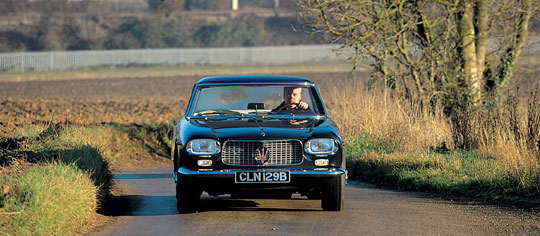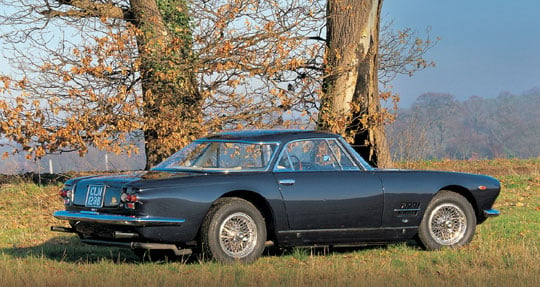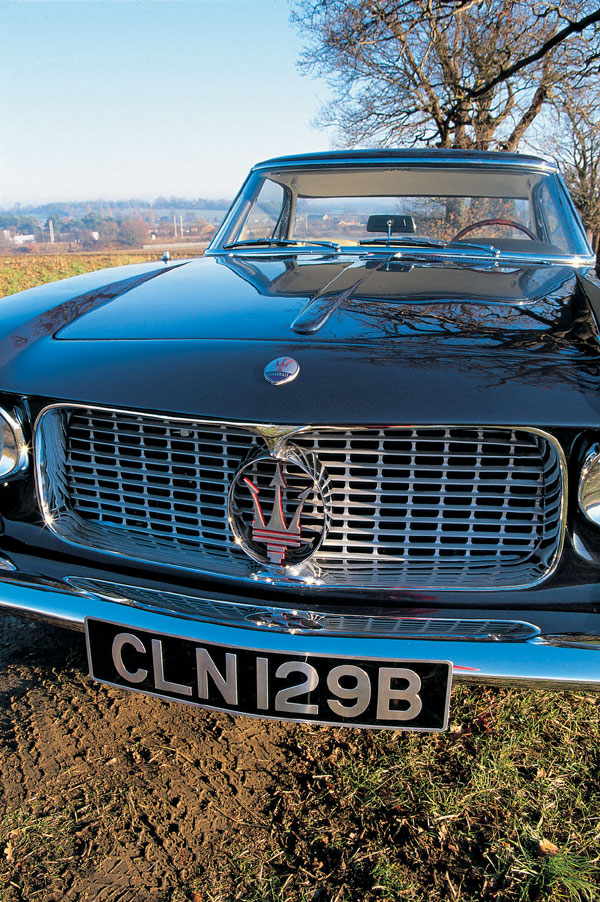
The following is an edited extract from Auto Italia magazine, May 2004. For access to the full feature, plus articles on the Sharknose 1960s F1 Ferraris, Driving the Nordschleife, Ferrari 612 and Lamborghini Gallardo road tests and much more, see www.auto-italia.co.uk
I have finally driven a Maserati 5000GT. It has been a long time coming, almost eight years in fact, and to do so I first had to build the car. Of all the 5000GTs, Allemano-bodied cars represent the largest proportion – some 22 of the 34 examples built. They were the production version of the car; built for royalty, the rich and the famous.
The stark and empty bodyshell that arrived at Bill McGrath Maserati in 1996 was familiar, but no less majestic for that. A previous restorer’s valiant failure had just become our latest and greatest jigsaw puzzle and the body was a blank canvas on which we were charged to recreate the 1963 5000GT Allemano, chassis 046.

There is precious little in the way of technical information available on any classic Maserati and for something as rare as a 5000GT, it wasn’t even worth asking. The suspension and braking systems are standard 3500GT and the gearbox looked suspiciously like that from a Ghibli. Even some parts of the engine were recognisable - except that when we looked closer, everything was just slightly different.
The double wishbone suspension was overhauled and a dead Quattroporte gave up its brake calipers to replace the missing originals. The rear leaf springs were similarly restored and the Salisbury axle sent away to GKN for a rebuild and to be fitted with a limited-slip differential.
Much of this car was carried over from the 3500GT, including the majority of the chassis with its oval tubes and box-section sills. It soon became clear that every 5000GT was in reality a prototype. Interestingly, although learned tomes on the subject claim that no 5000GT was ever fitted with air-conditioning, the period ‘Frigiking’ system that arrived with this car suggested otherwise.
We had yet to tackle the engine, a complex mixture of elements drawn from the experience of its designer, Giulio Alfieri. Like the earlier straight six, the five-litre uses twin plugs per cylinder, but fed unusually by two Lucas distributors. Lucas mechanical fuel injection is also used but with an eight-cylinder metering unit and higher capacity injectors than on the 3500GTI. While the chromed external water pipes are pure Maserati racer, the lower half of the engine is more familiar road car V8.
 During the build, we were determined to keep the metallic green colour on the cylinder heads, a five-litre signature. Scrapings were removed from the one remaining area on a cam cover and matched by a local paint supplier. Further evidence of the bespoke nature of the 5000GT engine is demonstrated by the fact that the cam covers and enormous wet sump are cast not in the usual aluminium, but in magnesium alloy. In the end, most of the moving parts were replaced. Every aspect of the engine screamed extreme power but extreme patience was required to actually bring it all together, never more so than on discovering that the beautiful swan neck inlet manifolds which dovetail together cannot be fitted after the cylinder heads have gone on. A second set of head gaskets later and the engine was ready for fitting.
During the build, we were determined to keep the metallic green colour on the cylinder heads, a five-litre signature. Scrapings were removed from the one remaining area on a cam cover and matched by a local paint supplier. Further evidence of the bespoke nature of the 5000GT engine is demonstrated by the fact that the cam covers and enormous wet sump are cast not in the usual aluminium, but in magnesium alloy. In the end, most of the moving parts were replaced. Every aspect of the engine screamed extreme power but extreme patience was required to actually bring it all together, never more so than on discovering that the beautiful swan neck inlet manifolds which dovetail together cannot be fitted after the cylinder heads have gone on. A second set of head gaskets later and the engine was ready for fitting.
For once during a Maserati restoration, fitting up the interior and the chromework, complete with a new pair of, yes, Citroen Ami 8 headlights, was the easy bit. Even the exhaust system required a trip to the Panini museum to inspect an example before I could understand how the various convolutions came together. From the engine there are two ‘four into two’ manifolds, joined at the beginning of each sill to vertical silencers. At the rear of the sills, the pipes go under the axle before crossing over through two transverse silencers to exit on either side of the car. It was a very expensive system to make in stainless steel and certainly not one that could be bought off the shelf.
All work stopped when the five-litre burst into life. After the familiar whine of the Lucas fuel pump building up to its 100psi working pressure, there followed a very unfamiliar mechanical cacophony as the big V8 fired. After a few minutes, eyes were beginning to smart and so first gear was selected and – tentatively – the car moved out into the sunlight for the first time in at least 10 years. I couldn’t wait to get out on the open road.
By modern standards, it’s all unfeasibly heavy. The throttle cable on these cars actually pushes rather than pulls which gives it some weight. The unassisted steering wilts under the heavy engine, and the clutch is heavy. But all is forgotten as you pull away. This motor has a much more urgent feel than the later V8. Lucas injection gives it instant throttle response, meaning it will blip deliciously between gearchanges – not that you really need to stir it along as it is stunningly flexible, something which allowed Maserati to give the five-litre really long legs.
Tall gear ratios and a giant axle ratio mean that this car really could achieve the lofty maximum speeds that made it famous. We calculated that at the 6,000rpm limit in third gear, the 5000GT would be doing 112mph – and it has a five-speed box.
Even the handling is not the razor-edge nightmare one might think. The extra weight and extra power over a 3500GT do make their presence felt at all times, but there is plenty of warning of impending trouble. Only the brakes demand a ’60s point of view. There cannot be too many high-speed stops with those solid discs before they turn blue and the overall lack of bite is a constant reminder.
Most of this, of course, I already knew, but what I would never have appreciated from research alone was the flexibility and the docile nature of what was billed as a racing engine for the road. Stupid of me really, for I have been driving and living with the designs of Giulio Alfieri for long enough to appreciate that he had an uncanny ability to produce cars without compromise. For all the power and excitement, there is equal refinement and breeding. It really is a car fit for a king.
|
Words by Andy Heywood. Pictures courtesy of Phil Ward and Auto Italia magazine.
See www.auto-italia.co.uk or call 01858 438817 for back issues and subscriptions. |




